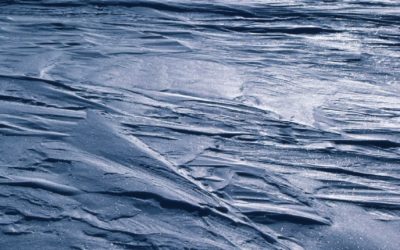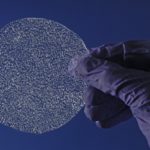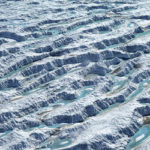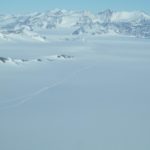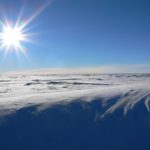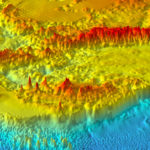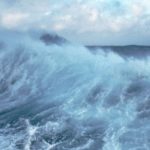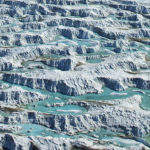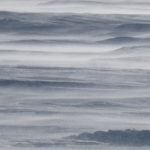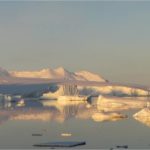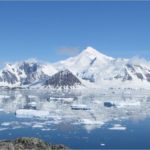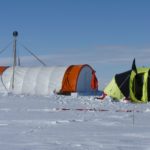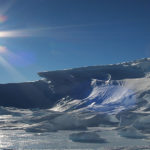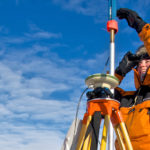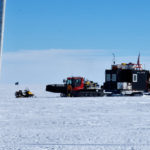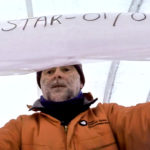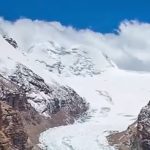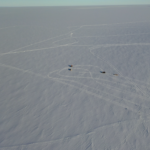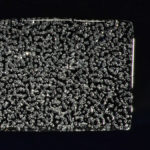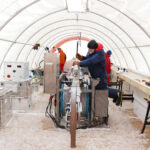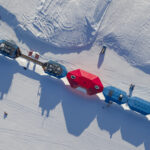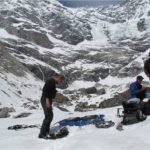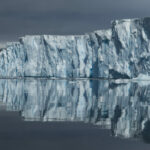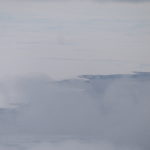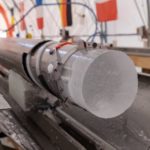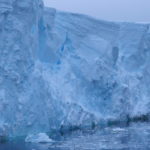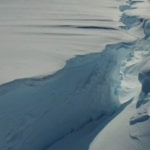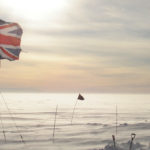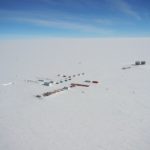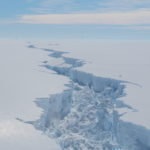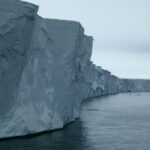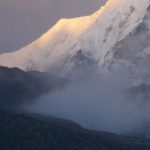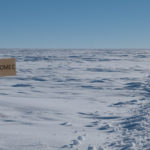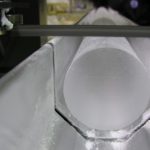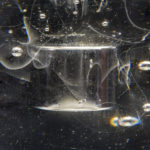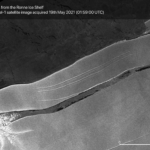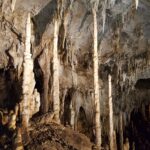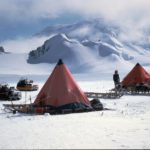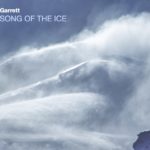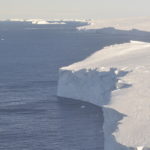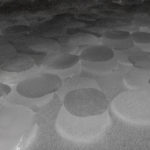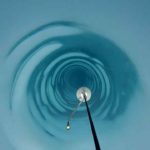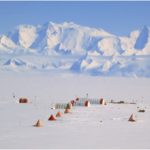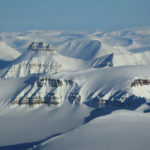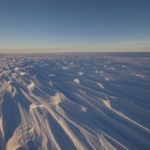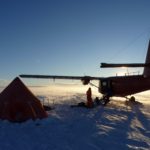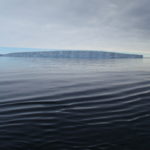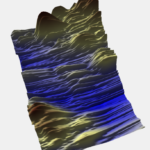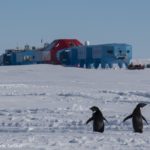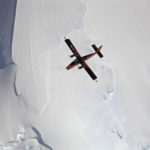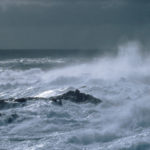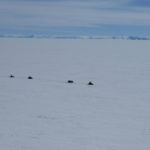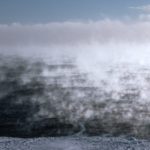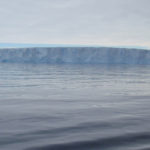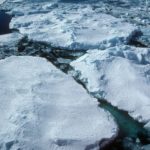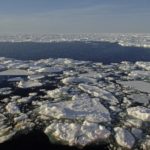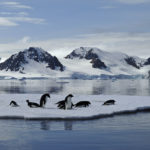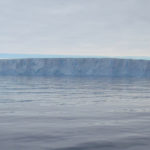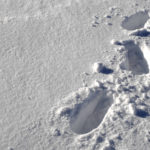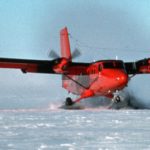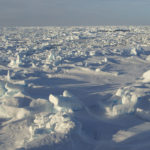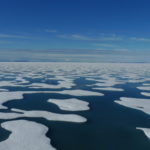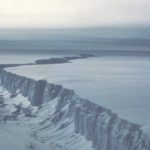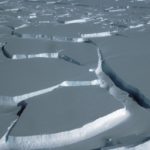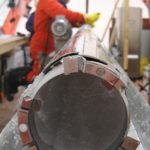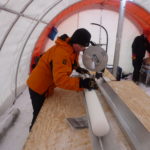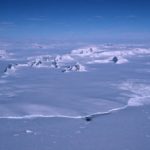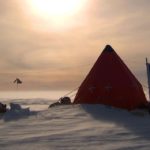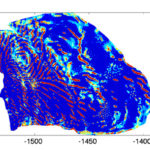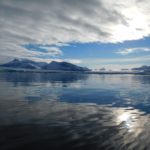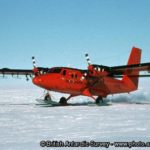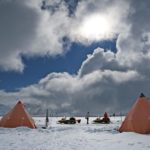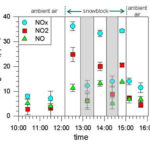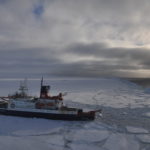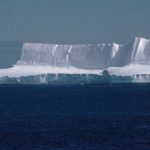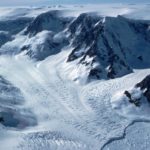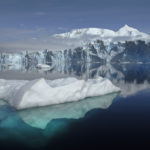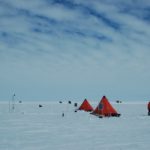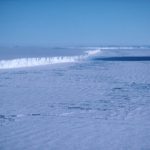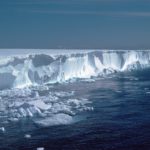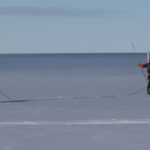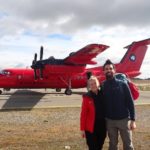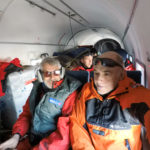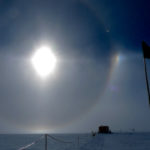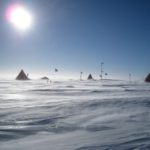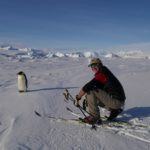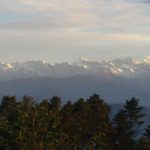Ice Dynamics and Palaeoclimate team
The Ice Dynamics and Palaeoclimate Team aims to improve understanding of glaciers and ice sheets and their response to climate change. This is essential for reducing uncertainties in predictions of future ice loss from the polar regions and mountain cryosphere, the impact of which will be felt by people worldwide in terms of sea level change and water security.
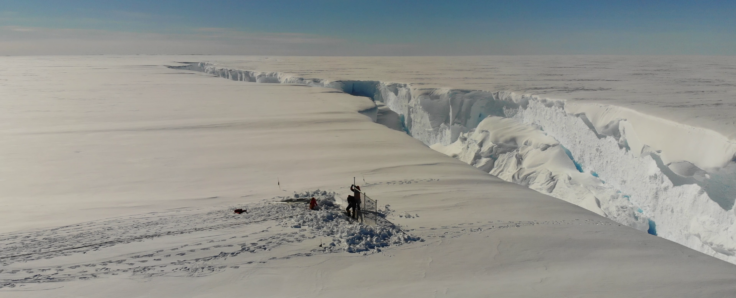
We work across the BAS Science Strategy ‘Polar Science for a Sustainable Planet’ to provide scientific evidence required by decision makers to realise a sustainable future. To do this, we undertake observational campaigns in the polar and mountain regions; conduct laboratory work (particularly in ice core science); and develop and run state of the art models of the ice sheets and the wider Earth system. Our expertise in ice core research enables us to tie together knowledge of past ice sheet behaviour and climate changes to assess the likelihood of future polar changes. We focus on both abrupt tipping points and longer timescale mass loss and gain from the past to the present day. By combining all these strands of research, and by working in partnership with the international glaciological and climate community, we can contribute to the global effort to understand climate and global sea level change, which together are two of the greatest challenges facing society today.
Science priorities
- Antarctic ice shelf changes. Antarctic ice shelves are crucial in preventing rapid ice loss from Antarctica. We observe and model the current ongoing losses from these shelves.
- Current and future mass balance and glacier response to climate change. We aim to understand the drivers of current changes in mass balance over rapidly thinning regions of Antarctica, including the immense Pine Island and Thwaites glaciers in West Antarctica. These insights are essential for developing and testing the models we use to make projections of future change leading to global sea level rise.
- Sea level rise and the ice sheet stability in past warm periods. We help determine the risk of future sea level rise by investigating the extent of ice loss from the West Antarctic and Greenland ice sheets during past warm periods.
- Mountain glacier water resources. Changes in the water contained in the global mountain cryosphere pose a global threat to water security, energy security and livelihood for many millions of people. We work to assess changes in mountain water resources by making observations of snow and ice accumulation and melt in mountain regions using novel, innovative instruments developed in-house.
- Changes in the Earth’s climate system. We acquire and analyse ice from polar ice sheets, sub-Antarctic islands and mountain glaciers to understand global climate and the atmospheric composition of greenhouse gases over decadal to millennial timescales. We reconstruct atmospheric circulation (winds) and sea ice to explore their role in driving Antarctic mass balance and the uptake and release of CO2 from the Southern Ocean.
Technology, innovation and training
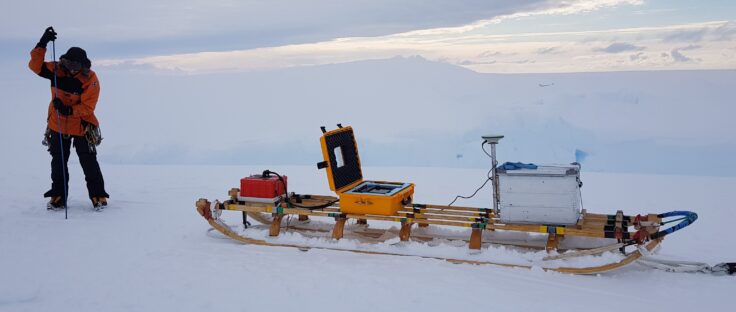
- We train the next generation of polar scientists through PhD programmes and grant-funded post-doctoral research positions.
- We develop key UK models, including the in-house WAVI ice sheet model and the UK Earth System Model (UKESM), to enable an improved understanding and representation of key physical processes occurring in the ice/Earth system.
- We deploy a wide range of field-based measurement systems including ice drilling, ice radar and seismic instruments, to evaluate and improve our models.
- We develop new innovations in field measurements, including in ice core technologies, ice radar and snowfall sensors, which open up new scientific opportunities.
- We develop and utilise the new instruments for use in laboratory-based measurements of ice cores.
Influencing and leading international programmes
- Play a strong leadership role and make relevant contributions to the Scientific Committee for Antarctic Research (SCAR) Research Programmes (Past Antarctic Ice Sheet Dynamics – PAIS), Themes (Antarctica and Climate; Ice Sheet & Under the Ice) and the Standing Science Group on Physical Sciences (IPICS, ISMASS)
- Work with leading UK and international partners who conduct Arctic and Antarctic research, including those that are involved with the Intergovernmental Panel on Climate Change (IPCC), including the Coupled Model Intercomparison Project (CMIP)
- Take a leading role in the International Partnership for Ice Core Sciences (IPICS) and the EU funded ‘Beyond EPICA’ project to recover the world’s oldest ice core.
Stakeholder engagement
- Produce policy briefings and presentations for UK Government departments including the Department of Science, Innovation and Technology (DSIT).
- Produce targeted science updates and briefings on the impact and relevance of our research for our funders, including NERC (Natural Environment Research Council).
- Support the Antarctic Treaty system by provision of research and expert advice on environmental change via the UK Foreign, Commonwealth and Development Office Polar Regions Department.
Public engagement in research
- Work with the BAS Communications Team to explain our science and its relevance for environmental stewardship to a wide range of public audiences.
- Collaborate with Cambridge University Institute for Sustainable Leadership to inform senior business leaders from a wide range of industries about climate change.
- Provide visitors to BAS with the chance to experience climate research at first hand with visits to the ice core laboratories and cold room, guided by experienced scientists
- Maintain displays of climate research, such as at the Science Museum and the Natural History Museum and seek further similar publicly accessible displays
SubICE
The Sub-Antarctic – ice coring expedition (SubICE), part of the international Antarctic Circumnavigation Expedition (ACE), successfully drilled several shallow ice cores, from five of the remote and globally significant sub-Antarctic …Impact of Melt on Ice Shelf Dynamics and Stability (MIDAS)
Project MIDAS (Impact of Melt on Ice Shelf Dynamics And Stability) is a UK-based Antarctic research project, investigating the effects of a warming climate on the Larsen C ice shelf …Seismic investigation of a subglacial lake
Field Team includes: Alex Brisbourne (BAS), Andrés Rivera (CECs), Rodrigo Zamora (CECs), Field Guide (BAS). Antarctic subglacial lakes contain unique records of ice sheet history and microbial life; they may …Beyond Epica
A decade ago, the European EPICA project completed drilling a deep ice core at Dome C, revealing the close link between climate and atmospheric greenhouse gases over the past 800,000 …Bedmap2
understanding whats beneath the ice, opens new opportunities for detailed modelling of the past and future evolution of the Antarctic ice sheetsBedmap Himalayas
Bedmap Himalayas is an ongoing BAS core-funded and grant-funded programme. It aims to measure how much water much is stored as glacier ice in High Mountain Asia. In warm weather, …Past Westerly Winds
The behaviour of the westerly wind belt (see Figure 1a) over the Southern Ocean during cold glacial periods has been debated for many years. These winds matter because explanations of …Weddell Sea ice sheet and climate
In the south of the Weddell Sea lies the Ronne and Filchner Ice Shelves. During the coldest part of the last glacial period about 25,000 years ago, the ice in …RAID
Ice cores take a long time to collect. The 3.4 km- ice core drilled at Dome Concordia (Antarctica) took 5 years to collect and encloses the oldest ice drilled so …Ocean-driven ice-shelf thinning in Antarctica
By exploiting advances in ice sheet modelling, and new Antarctic-wide datasets, this project aims to predict how far and how fast the observed ocean-driven thinning of floating ice shelves will …Ice Sheet Modelling
The research of the ice sheet modelling group focuses on integrating observational data with dynamical models that describe how the ice flows in order to improve our representation of how …Climate and Ice during the Last Interglacial
During the Last Interglacial (129-116 thousand years ago, ka) CO2 and global temperature were both higher than they were before human industrialisation. By examining Last Interglacial climate, we thus gain …Antarctic Climate over the last millennia
The Antarctic Peninsula and West Antarctica have warmed dramatically in recent decades, with some climate records indicating that these are among the most rapidly warming regions on Earth. The Antarctic …West Antarctica wind strength and atmospheric circulation
Changes in wind strength and circulation patterns above the Antarctic Peninsula are linked to its warming and increased upwelling of warm circumpolar deep water, resulting in accelerated melting and thinning …Filchner Ice Shelf System, Antarctica
Understanding the contribution that polar ice sheets make to global sea-level rise is recognised internationally as urgent. The mission of this five-year project is to capture new observations and data …iSTAR – Stability of the West Antarctic Ice Sheet
Science on the move - the mission to understand the stability of the West Antarctic Ice SheetiSTAR-C Dynamical control on the response of Pine Island Glacier
iStar-C - strives to understand the dynamical control and response to change of Pine Island GlacieriStar-D The contribution to sea-level rise from the Amundsen Sea sector of Antarctica
iStar-D will identify the potential contribution to sea-level rise, from ice locked in the Amundsen Sea sector of AntarcticaWater isotopes in UKESM2
We will add water tracers (including stable water isotopes) to the UK Earth System Model (UKESM2) which will track through the model’s hydrological cycle. This work started under the EU …SURFEIT
Surface Fluxes in Antarctica (SURFEIT) is a BAS National Capability International research programme. Its primary aims are to bring together relevant members of the international scientific community and increase our …SDOO
Abrupt warming episodes punctuate Greenland ice core records throughout the last glacial period. These events were first identified in two Greenland stable water isotope records (Dansgaard et al., 1993), and …SIWHA
The NERC funded SIWHA_CO2 project “Sea Ice and Westerly winds during the Holocene in coastal Antarctica, to better constrain oceanic CO2 uptake” will be a breakthrough in our understanding of how …The Big Thaw
The Big Thaw is an ambitious new UKRI/NERC-funded Highlight Topic project assessing past, present and future changes in global mountain water resources by studying snow/ice accumulation and melt in the …Scientists one step closer to predicting iceberg calving
16 April, 2024
Scientists are a step closer to being able to predict when large icebergs will calve in Antarctica. A team of glaciologists will present their new results at the European Geoscience …
Antarctic ice explains dip in CO2 levels
5 March, 2024
Small bubbles of air from ice in Antarctica resolve a long-standing debate about why there was a decline in atmospheric carbon dioxide (CO2) during the 16th and 17th centuries. The …
Ice cores reveal rapid Antarctic ice loss in the past
8 February, 2024
The first direct evidence that the West Antarctic Ice Sheet shrank suddenly and dramatically at the end of the Last Ice Age, around eight thousand years ago, is published in …
Team embarks on mission to investigate iceberg calving
8 January, 2024
Halley Research Station, Antarctica – A team of scientists from the British Antarctic Survey (BAS) is gearing up for an expedition to the Brunt Ice Shelf in Antarctica to unravel …
Hamish Pritchard awarded Innovation in Meteorology Prize
5 October, 2023
British Antarctic Survey glaciologist Hamish Pritchard has won the 2023 Harry Otten Prize for Innovation in Meteorology. His idea, Lakes as snowfall sensors: solving the precipitation problem in the mountain …
Antarctica’s glacial border moves for miles with the tide
26 September, 2023
New measurements of how the boundary between onshore glacier and floating ice shelf glides back-and- forth could help predict melting The grounding line of the southern Ronne Ice Shelf in …
First images of giant iceberg from Brunt Ice Shelf
13 March, 2023
ANTARCTICA – 13 March 2023. British Antarctic Survey (BAS) has released the first aerial pictures of the massive A81 iceberg that calved from the Brunt Ice Shelf in late January. …
Oldest ice drilling campaign reaches key milestone
7 February, 2023
Scientists in East Antarctica drilling to find the Earth’s oldest ice have reached a key milestone after two months of fieldwork in sub-zero temperatures. The team is part of Beyond …
New funding to predict future sea-level rise in Antarctica
2 February, 2023
Researchers at British Antarctic Survey (BAS) will develop new and ambitious ideas to tackle critical global environmental challenges, such as global sea-level rise from Antarctica, thanks to new funding. The …
Brunt Ice Shelf in Antarctica calves giant iceberg
23 January, 2023
ANTARCTICA – 23 January 2023. A huge iceberg (1550 km²), almost the size of Greater London, has broken off the 150m thick Brunt Ice Shelf. It calved after cracks that …
Fieldwork starts on Thwaites Glacier
13 December, 2022
Nearly 60 scientists and support staff are on their way to Thwaites Glacier in West Antarctica. It’s part of an ambitious international effort to understand the glacier and surrounding ocean …
Beyond EPICA deep drilling campaign begins
7 December, 2022
Scientists return to East Antarctica this month (December) to locate the oldest ice on Earth. The team is part of an EU-funded research consortium from 10 European countries whose aim …
Glaciers in the spotlight on BBC’s Our Frozen Planet
11 October, 2022
How much water the mountain glaciers of the Himalayas contain and how the mighty Thwaites Glacier in West Antarctica will contribute to global sea-level rise form part of the final …
Scientists expose vulnerabilities of critical Antarctic ice shelf
21 September, 2022
Pine Island Ice Shelf in West Antarctica, which holds back enough ice to raise sea levels by 0.5 metres, could be more vulnerable to complete disintegration than previously thought. A …
Study sets course for research on Himalayan waters
22 April, 2022
A new study featuring contributions from British Antarctic Survey (BAS) scientists has identified 100 pressing research questions on climate change and water resources in the Upper Indus Basin (UIB) that must be answered to protect the communities that live there.
Drilling of oldest ice on Earth completed
18 February, 2022
The first ice core drilling campaign of Beyond Epica-Oldest Ice has been successfully completed at the remote Little Dome C site in Antarctica – one of the most extreme places …
Mission to drill Antarctica’s oldest ice
30 November, 2021
The first campaign to drill Antarctica’s oldest ice starts this month (November). Beyond EPICA-Oldest Ice aims to drill an ice core to collect a record of past climate spanning 1.5 million years
Immersive science-art exhibition opens at Glasgow Science Centre
29 September, 2021
A new immersive exhibition, Polar Zero, opens at Glasgow Science Centre this weekend (2 October), injecting an artistic and cultural dimension to the climate negotiations at the Conference of the …
Polar Zero: visual arts take centre stage at COP26
29 June, 2021
Immersive science-art ice core research exhibition to be displayed at Glasgow Science Centre during COP26
Antarctica wasn’t as cold during the last ice age as previously thought, new study shows
4 June, 2021
A study of two alternative methods for reconstructing ancient temperatures has given climate researchers a better understanding of how cold it was in Antarctica during the last Ice Age, around …
The world’s largest iceberg
21 May, 2021
An enormous iceberg has calved from the western side of the Ronne Ice Shelf, in Antarctica. The iceberg, newly named A-76, measures around 4320 sq km in size and is …
Synchronous timing of past abrupt climate changes
21 August, 2020
New research has revealed that climate changes associated with past episodes of abrupt warming in Greenland occurred synchronously across a region extending from the Arctic to the Southern Hemisphere subtropics. …
Drilling projects set to break new ground
29 April, 2020
Two new research projects – in partnership with British Antarctic Survey engineers – will drill deeper than ever before in Antarctica and in space. The first project, called INCISED, is …
Earth Day 2020: The Song of the Ice
22 April, 2020
*Did you miss the live event on 22 April? The recording is now available to watch below, or on Youtube via: https://youtu.be/8r3xdrp5GGI* Online launch of The Song of the Ice …
Scientists drill for first time on remote Antarctic Glacier
28 January, 2020
Teams from the US and UK have successfully completed scientific fieldwork in one of the most remote and hostile areas of West Antarctica – coinciding with the 200th anniversary of …
Ice core inspired art installation opens in London
26 November, 2019
A new climate change artwork – Ice Floor, a new Phase 2 by Wayne Binitie, opens this week at Arup’s Fitzroy Street offices in London. The work was developed in …
New mission for 1.5 million year climate record
9 April, 2019
This week a team of European researchers announces its plans for an ambitious mission to find the oldest ice on Earth (9 April 2019). Antarctica’s ice has the potential to …
Arctic sea ice loss in past linked to abrupt climate events
12 February, 2019
A new study on ice cores shows that reductions in sea ice in the Arctic in the period between 30-100,000 years ago led to major climate events. During this period, …
Scientists drill to record depths in West Antarctica
24 January, 2019
A team of scientists and engineers has for the first time successfully drilled over two kilometres through the ice sheet in West Antarctica using hot water. This research will help …
Scientists complete remote ice core drilling mission
10 January, 2019
A team of scientists and engineers from British Antarctic Survey and the University of Cambridge has successfully drilled over 650 metres in to an Antarctic ice cap to obtain an …
Increased snowfall in Antarctica buffers sea-level rise
10 December, 2018
A new study of snowfall across Antarctica provides vital information in the study of future sea-level rise. A team of scientists from NASA and British Antarctic Survey (BAS), describes how …
Prestigious award for BAS early career scientist
6 November, 2018
Congratulations to Dr Emilie Capron who has been awarded the prestigious Early Career Scientist Award of the International Union of Geodesy and Geophysics (IUGG). Dr Capron is a palaeoclimatologist at British …
Measuring glaciers in the Himalayan mountains
11 October, 2018
Technology pioneered in Antarctica could soon be providing much-needed data on the amount of ice in the glaciers of High Mountain Asia thanks to an ingenious helicopter-mounted, low-frequency radar developed …
New study reveals increased snowfall in Antarctica over last two centuries
9 April, 2018
The first comprehensive study of snowfall across Antarctica provides vital information in the study of future sea-level rise. Presenting this week (Monday 9 April 2018) at the European Geosciences Union …
Tiny ice losses at Antarctica’s fringes can accelerate ice loss far away
11 December, 2017
A thinning of small areas of floating ice at Antarctica’s coast can accelerate the movement of ice grounded on rocks hundreds of kilometres away, a new study involving scientists from …
Maps reveal landscape beneath Antarctica’s weak underbelly
20 November, 2017
A UK team of researchers has produced high-resolution maps of the bed beneath a major glacier in West Antarctica, which will help them predict future sea-level rise from this region. …
Halley Research Station will not winter in 2018
31 October, 2017
British Antarctic Survey (BAS) has decided, for safety reasons, that it will close its Halley VI Research Station during the 2018 Antarctic winter. This will be the second time that …
Impact of giant Antarctic iceberg – update on Larsen-C
2 August, 2017
The largest remaining ice shelf on the Antarctic Peninsula lost 10% of its area when an iceberg four times the size of London broke free earlier this month. Since …
FEATURED PAPER: Winds and sea ice
23 March, 2017
It is thought that wind changes over the Southern Ocean may have been critical in driving changes in CO2 between cold ice-world and warm-world climates. Because of inconsistencies between the …
Giant iceberg set to calve from Larsen C Ice Shelf
6 January, 2017
A huge iceberg, roughly the size of Norfolk, looks set to break away from the Larsen C ice shelf on the Antarctic Peninsula. Larsen C is more than twice the size …
Quest begins for oldest ice on Earth
14 November, 2016
First phase of project to collect 1.5 million years of climate data in Antarctica A team of European scientists heads to East Antarctica this month to locate the oldest ice …
FEATURED PAPER: Sea-ice reduction
18 October, 2016
A team of British climate scientists comparing today’s environment with the warm period before the last ice age has discovered a 65% reduction of Antarctic sea ice around 128,000 years …
FEATURED PAPER: Tidal controls on ice streams
18 October, 2016
The often large ocean tides around Antarctica can greatly affect the flow of ice streams even long distances upstream of their grounding lines. Observing and modelling this interaction serves as …
Ancient ice inspires Royal College of Art glass artist
8 October, 2016
Data as art captivates a London audience
New interactive game ‘Ice Flows’ launches today
23 August, 2016
Researchers and games developers have joined forces to explain how climate change is affecting Antarctica. A new game called ‘Ice Flows’ launches today (Tuesday 23 August) at an international science meeting in Malaysia.
New Antarctic ice discovery aids future climate predictions
16 August, 2016
A team of British climate scientists comparing today’s environment with the warm period before the last ice age has discovered a 65% reduction of Antarctic sea ice around 128,000 years …
Polar ice reveals secrets of carbon-climate feedbacks
26 July, 2016
An international team of scientists have used air bubbles in polar ice from pre-industrial times to measure the sensitivity of the Earth’s land biosphere to changes in temperature.
FEATURED PAPER: Improved modelling of ice-ocean processes
19 May, 2016
Pine Island Glacier in West Antarctica is currently one of the single biggest contributors to sea-level rise with an estimated volume loss of 1.2mm sea-level equivalent per decade. The loss …
FEATURED PAPER: Recent snowfall increase
16 December, 2015
This paper reveals that the amount of snowfall in coastal West Antarctica has increased during the 20th century, with annual snow accumulation since the 1990s the highest we have observed …
PRESS RELEASE: New season – ambitious science
23 November, 2015
New season tackles ambitious science and logistical challenges The British Antarctic Survey (BAS) 2015/16 field season is underway with dozens of scientists and support staff – together with planes and tonnes …
FEATURED PAPER: Improving climate predictions
19 November, 2015
The Earth’s climate was warmer than today by at least 1°C during the Last Interglacial (between 129,000 and 116,000 years ago). Thus, the Last Interglacial represents an invaluable case study …
NEWS STORY: Sea-level rise from Antarctic collapse
19 November, 2015
Sea-level rise from Antarctic collapse may be slower than suggested A new study by scientists in the UK and France has found that Antarctic ice sheet collapse will have serious …
PRESS RELEASE: West Antarctica snow accumulation
4 November, 2015
West Antarctic coastal snow accumulation rose 30 percent during 20th century Annual snow accumulation on West Antarctica’s coastal ice sheet increased dramatically during the 20th century, according to a new …
FEATURED PAPER: Glacier response to ice shelf collapse
12 August, 2015
In February 2002, satellite images from a remote location in Antarctica revealed how an immense volume of floating ice, up to 1km thick, suddenly collapsed. Over the course of a …
NEWS STORY: New iSTAR season starts
11 November, 2014
Scientists head to Pine Island Glacier for new research season A team of twelve scientists and support staff has arrived on Pine Island Glacier in West Antarctica in the second …
NEWS STORY: Ice shelf break up explained
12 September, 2014
Antarctic Team Discovers Mechanism for Massive Ice Shelf Collapse New research has found that the cataclysmic break-up of a large floating ice shelf in the early 2000’s was primarily the …
NEWS STORY: Sea levels rising faster in Antarctica
1 September, 2014
Antarctic sea-level rising faster than global rate A new study of satellite data from the last 19 years reveals that fresh water from melting glaciers has caused the sea-level around …
NEWS STORY: Changes in winds in south
12 May, 2014
Ocean winds keep Australia dry and Antarctica cold New research explains why Antarctica is not warming as much as other continents, and why southern Australia is recording more droughts. Analysis …
NEWS STORY: Unlocking clues to past climate
1 May, 2014
Earth’s last warm phase exposed Analysis of data collected from ice cores and marine sediment cores in both polar regions has given scientists a clearer picture of how the Earth’s …
PRESS RELEASE: Glacier’s thinning charted
20 February, 2014
Previous rapid thinning of Pine Island Glacier sheds light on future Antarctic ice loss New research, published this week in Science, suggests that the largest single contributor to global sea …
NEWS STORY: First phase of glacier mission ends
10 February, 2014
First leg of Antarctic iSTAR mission accomplished A team of British scientists has returned from a gruelling 1500km journey across the ice of West Antarctica after successfully completing the first …
NEWS STORY: Glacier thinning at point of no return
14 January, 2014
Focus on Pine Island Glacier, Antarctica Pine Island Glacier, on the West Antarctic Ice Sheet (WAIS) is the largest single contributor to sea-level rise in Antarctica. The stability of the …
NEWS STORY: Climate records from ice cores
5 December, 2013
New ice core record shows climate variability in West Antarctica A 308-year ice core record provides new data on climate variability in coastal West Antarctica and shows that a clear …
NEWS STORY: “Stripes” hinder ice flow
8 November, 2013
Tiger stripes’ under Antarctic glacier slow the flow Narrow stripes of dirt and rock beneath massive Antarctic glaciers create friction zones that slow the flow of ice toward the sea, …
NEWS STORY: Ice melt rates measured
13 September, 2013
Antarctic research details ice melt below massive glacier An expedition of international scientists to the far reaches of Antarctica’s remote Pine Island Glacier has yielded exact measurements of an undersea …
NEWS STORY: Mission to Pine Island Glacier
9 September, 2013
Ambitious science mission sets off for Antarctica A team of British scientists is making final preparations for an ambitious Antarctic science mission. They aim to discover what’s causing the recent …
NEWS STORY: Measuring icequakes
28 August, 2013
Icequakes unlock secrets of icestreams Measuring tiny icequakes is helping British Antarctic Survey scientists investigate ice streams despite the challenging environment they have to work in. The work of Emma …
PRESS RELEASE: Increase in melt rates on Antarctic Peninsula
14 April, 2013
New insight into accelerating summer ice melt on the Antarctic Peninsula A new 1000-year Antarctic Peninsula climate reconstruction shows that summer ice melting has intensified almost ten-fold, and mostly since …
NEWS STORY: Royal Society accolade for expert
20 March, 2013
Top scientist receives Royal Society Research Professorship to fund long-term UK research A Royal Society Research Professorship has been awarded to one of British Antarctic Survey’s leading climate scientists Professor …
NEWS STORY: Greenland ice shows past trends
23 January, 2013
Greenland ice core reveals warm past temperatures British Antarctic Survey scientists have contributed to a new study published in Nature (Thursday 24 January) that provides surprising details on changes in …
PRESS RELEASE: Assessing potential sea level rise
16 January, 2013
New Antarctic geological timeline aids future sea-level predictions Radiocarbon dates of tiny fossilised marine animals found in Antarctica’s seabed sediments offer new clues about the recent rapid ice loss from …
NEWS STORY: Sea level rise calculated
30 November, 2012
British Antarctic Survey researchers part of landmark study to improve projections for future sea level An international team of satellite experts including researchers at British Antarctic Survey has produced the …
NEWS STORY: Surfaces of glaciers studied
29 October, 2012
The effects of microbial life on glaciers and ice sheets Around 10% of the Earth’s surface is covered by glacial ice (glaciers and ice sheets), some of which melt as …
PRESS RELEASE: Ice sheet behaviour analysed
17 October, 2012
Ice sheet retreat controlled by the landscape Ice-sheet retreat can halt temporarily during long phases of climate warming, according to scientists. A UK team led by Durham University has found …
PRESS RELEASE: Antarctica’s climate timeline
22 August, 2012
New climate history adds to understanding of recent Antarctic Peninsula warming Results published this week by a team of polar scientists from Britain, Australia and France adds a new dimension …
NEWS STORY: Assessing potential sea level rise
10 May, 2012
New studies improve scientists’ understanding of the potential contribution of the Antarctic Ice Sheet to global sea level rise Three peer-reviewed papers in Nature and Nature Geoscience published in recent …
PRESS RELEASE: Study of largest glacier
5 December, 2011
Scientist on BBC Frozen Planet investigates how world’s largest glacier is contributing to sea-level rise A team of scientists from British Antarctic Survey (BAS) is to survey the largest glacier …
PRESS RELEASE: Greenland drilling progress
2 August, 2010
Greenland Ice Core Team Reaches Bedrock Bedrock has been reached Tuesday July 27 2010 at the deep ice core drilling site North Greenland Eemian Ice Drilling (NEEM) on the Greenland …
PRESS RELEASE: Ice thinning captured by satellites
23 September, 2009
Lasers from space show thinning of Greenland and Antarctic ice sheets The most comprehensive picture of the rapidly thinning glaciers along the coastline of both the Antarctic and Greenland ice …
PRESS RELEASE: 3D map aids ice flow estimates
20 July, 2009
New research provides insight into ice sheet behaviour A new study published this week takes scientists a step further in their quest to understand how Antarctica’s vast glaciers will contribute …
Satellite spies on doomed Antarctic ice shelf
19 March, 2002
PRESS RELEASE 19 March 2002 PR Number 5/2002 Satellite images have revealed the collapse of Larsen B ice shelf on the Antarctic Peninsula fulfilling predictions made by British Antarctic Survey …
BLOG: Looking into the world’s most studied ice shelf
19 April, 2024 by Emma Pearce
Understanding what is going on inside an ice shelf is important for many reasons. But mostly, it allows us to better understand their contribution to sea level rise, and to …
PODCAST – Iceworld, Episode 3 – Ice Cores
19 February, 2020 by Robert Taylor
In Episode 3, Isobel Rowell and Dieter Tetzner have just returned from several weeks in the field, drilling for ice alongside Dr Robert Mulvaney and field guides Sarah Crowsley and …
SCIENCE ON THE ICE – Part 1: The search for the oldest ice continues
23 November, 2017 by Robert Mulvaney
BAS glaciologist Dr Robert Mulvaney journeys deep into Antarctica where he and the team continue their search for the oldest ice record of atmosphere and climate – hopefully stretching back 1.5 million years.
ANTARCTIC BLOG: Working on the Polar Plateau
7 February, 2017 by Markus Frey
Ice core drilling is a large complex operation to firstly get the equipment out into the field, assemble it, drill intact columns of ice and then process the collected ice for analysis. Markus Frey explains.
ANTARCTIC BLOG: Journey to the Polar plateau
20 December, 2016 by Holly Winton
Our journey to the Antarctic Polar Plateau, where we will be spending the next few weeks as part of the ISOL-ICE research project, began on 7 December. We boarded a …
ANTARCTIC BLOG: Polar guide tackles the long wait #6
4 January, 2016 by Ashly Fusiarski
Life in Antarctica can be difficult but strangely the more difficult it is, the easier it becomes. Life starts to be simple. One only has to do whatever it takes. The …
ANTARCTIC BLOG: Polar guide reaches the ice – #3
10 November, 2015 by Ashly Fusiarski
The FISS project is huge on a logistical scale. Drilling through an eight hundred meter ice shelf and providing support and equipment for several seismic, radar and instrument inputs and …
ANTARCTIC BLOG: The journey South is long – #2
6 November, 2015 by Ashly Fusiarski
“Goodbyes” get harder each time so I avoid them by saying “See you later” as if I’m just going to the shop. The journey South is long and for me …
ANTARCTIC BLOG: Tales from a polar guide – #1
26 October, 2015 by Ashly Fusiarski
It’s four AM and I’m wide awake, staring at the deep blue and black shadows on the ceiling of my bedroom. I allow myself just this once to indulge in …
BLOG: A New Frontier – exploring the Himalaya
9 September, 2015 by Michael McCarthy
Earlier this year I spent two months doing fieldwork in the Hindu-Kush Himalaya mountain region in South and Central Asia. It hosts the largest volume of ice and snow outside the polar regions and, for this reason, …
Subglacial bedform and moat initiation beneath Rutford Ice Stream, West Antarctica
16 April, 2024 by Alex Brisbourne, Andy Smith, Ed King, Rebecca Schlegel
The accuracy of sea-level rise predictions is highly dependent on reliably understanding the subglacial environment beneath ice streams. Bedforms result from the interaction between ice and its substrate, and therefore…Read more on Subglacial bedform and moat initiation beneath Rutford Ice Stream, West Antarctica
WAVI.jl: Ice Sheet Modelling in Julia
14 March, 2024 by Alexander Bradley, Rosie Williams, David Bett, James Byrne, Robert Arthern
Ice sheet models are used to improve our understanding of the past, present, and future evolution of ice sheets. To do so, they solve the equations describing the flow of…A framework for estimating the anthropogenic part of Antarctica’s sea level contribution in a synthetic setting
11 March, 2024 by Alexander Bradley, Rosie Williams, David Bett, Paul Holland, Robert Arthern
The relative contributions of anthropogenic climate change and internal variability in sea level rise from the West Antarctic Ice Sheet are yet to be determined. Even the way to address…Reconciling ice core CO2 and land use change following New World-Old World contact
5 March, 2024 by Amy King, Ivo Strawson, Thomas Bauska
Ice core records of carbon dioxide (CO2) throughout the last 2000 years provide context for the unprecedented anthropogenic rise in atmospheric CO2 and insights into global carbon cycle dynamics. Yet…Read more on Reconciling ice core CO2 and land use change following New World-Old World contact
Lateral flexure of Erebus Ice Tongue due to ocean current forcing and fast ice coupling
29 February, 2024 by Oliver Marsh
ABSTRACT. Ice tongues are unconfined by land on their lateral margins and are sensitive to external forcing from the ocean. They are found sporadically around the Antarctic coast but are…Read more on Lateral flexure of Erebus Ice Tongue due to ocean current forcing and fast ice coupling
Investigating halogens and MSA in the Southern Hemisphere: A spatial analysis
15 February, 2024 by Dieter Tetzner, Dorothea Moser, Liz Thomas
Sub-Antarctic islands and Antarctic coastal regions provide valuable sites for investigating environmental processes in the Southern Ocean. The fact that these sites are situated within the sea ice zone underscores…Read more on Investigating halogens and MSA in the Southern Hemisphere: A spatial analysis
Evaporative controls on Antarctic precipitation: an ECHAM6 model study using innovative water tracer diagnostics
13 February, 2024 by Alison McLaren, Louise Sime, Qinggang Gao, Thomas Bracegirdle
Improving our understanding of the controls on Antarctic precipitation is critical for gaining insights into past and future polar and global environmental changes. Here we develop innovative water tracing diagnostics…Brief communication: Rapid acceleration of the Brunt Ice Shelf after calving of iceberg A-81
13 February, 2024 by Dominic Hodgson, Oliver Marsh
The Brunt Ice Shelf, Antarctica, accelerated rapidly from a velocity of 900 to 1500 m a−1 during 6 months, following calving of a 1500 km2 iceberg on 22 January 2023. The immediate response…Abrupt Holocene ice loss due to thinning and ungrounding in the Weddell Sea Embayment
8 February, 2024 by Amy King, Liz Thomas, Robert Mulvaney, Thomas Bauska
The extent of grounded ice and buttressing by the Ronne Ice Shelf, which provides resistance to the outflow of ice streams, moderate West Antarctic Ice Sheet stability. During the Last…Read more on Abrupt Holocene ice loss due to thinning and ungrounding in the Weddell Sea Embayment
DAS-N2N: machine learning distributed acoustic sensing (DAS) signal denoising without clean data
1 February, 2024 by Alex Brisbourne
This paper presents a weakly supervised machine learning method, which we call DAS-N2N, for suppressing strong random noise in distributed acoustic sensing (DAS) recordings. DAS-N2N requires no manually produced labels…Firn on ice sheets
23 January, 2024 by Dorothea Moser, Liz Thomas
Most of the Greenland and Antarctic ice sheets are covered with firn — the transitional material between snow and glacial ice. Firn is vital for understanding ice-sheet mass balance and…The significance of the melt-pond scheme in a CMIP6 global climate model
1 January, 2024 by Louise Sime
The impact of melt ponds on sea-ice albedo has been observed and documented. In general circulation models, ponds are now accounted for through indirect diagnostic treatments (‘implicit’ schemes), or prognostic…Read more on The significance of the melt-pond scheme in a CMIP6 global climate model
Decoupling of δ18O from surface temperature in Antarctica in an ensemble of Historical simulations [in review, Climate of the Past]
7 December, 2023 by Louise Sime
ater stable isotopes recorded in Antarctic ice cores have traditionally been used to infer past surface air temperatures (SAT). During the historical period (1850 onward), observational data and good quality…Drivers of late Holocene ice core chemistry in Dronning Maud Land: The context for the ISOL-ICE project [preprint]
5 December, 2023 by Markus Frey, Robert Mulvaney, Holly Winton
Quantifying the natural variability of the stratospheric ozone layer and understanding the underlying factors that control natural total column ozone (TCO) variability are required to put modern observations into historical…Array processing in cryoseismology: a comparison to network-based approaches at an Antarctic ice stream
27 November, 2023 by Alex Brisbourne, Andy Smith
Seismicity at glaciers, ice sheets, and ice shelves provides observational constraint on a number of glaciological processes. Detecting and locating this seismicity, specifically icequakes, is a necessary first step in…An unprecedented sea ice retreat in the Weddell Sea driving an overall decrease of the Antarctic sea-ice extent over the 20th century
16 November, 2023 by Diana Vladimirova, Dieter Tetzner, Liz Thomas
Sea-ice extent is predicted to decrease in a warming climate. However, despite global warming over the past century, total Antarctic sea ice remained relatively stable from 1979 until 2015, before…Deciphering stable water isotope records of firn cores from a strongly maritime, high-accumulation site on the Antarctic Peninsula
8 November, 2023 by Liz Thomas
Stable water isotope records of six firn cores retrieved from two adjacent plateaus on the northern Antarctic Peninsula between 2014 and 2016 are presented and investigated for their connections with…The Temporal Phasing of Rapid Dansgaard–Oeschger Warming Events Cannot Be Reliably Determined [in review, Climate of the Past]
7 November, 2023 by John Slattery, Louise Sime
Dansgaard–Oeschger (DO) warming events occurred throughout the last glacial period. Greenland ice cores show a rapid warming during each stadial to interstadial transition, alongside abrupt loss of sea ice and…Reconstructing the Antarctic ice-sheet shape at the Last Glacial Maximum using ice-core data
1 November, 2023 by Louise Sime
The Antarctic ice sheet (AIS) is the Earth’s largest store of frozen water; understanding how it changed in the past allows us to improve projections of how it, and sea…Measuring seismic attenuation in polar firn: method and application to Korff Ice Rise, West Antarctica
26 October, 2023 by Alex Brisbourne, Andy Smith, Ronan Agnew
We present seismic measurements of the firn column at Korff Ice Rise, West Antarctica, including measurements of compressional-wave velocity and attenuation. We describe a modified spectral-ratio method of measuring the…Science Leader

Deputy Science Leader
Share this
Featured
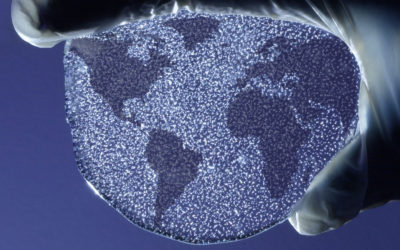
Science strategy
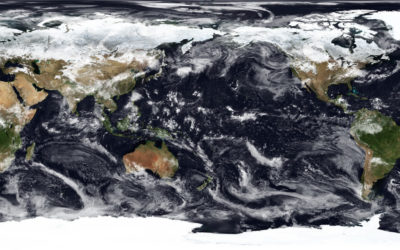
Private: Our Grand Challenges for polar science
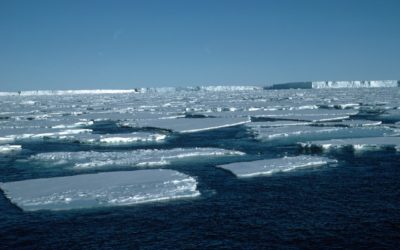
Climate science – influencing policy
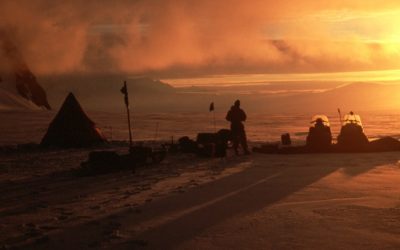
Climate & climate change
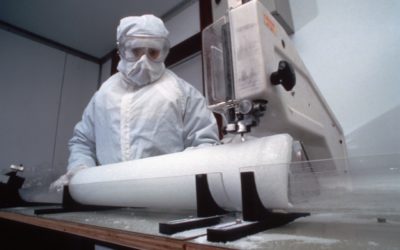
Ice & ice-movement
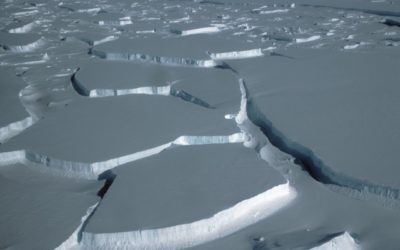
Sea-level rise
